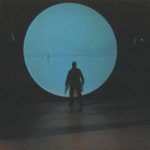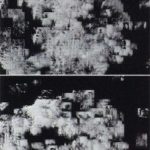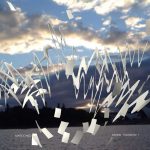Andrea Polli: Intuitive Ocusonics
Artist(s):
Title:
- Intuitive Ocusonics
Exhibition:
Creation Year:
- 2000
Medium:
- Performance
Category:
Artist Statement:
“Intuitive Ocusonics” is the five-year effort of Andrea Polli (www.andreapolli.com), an experimental programmer, sound artist, and technologist who takes social implications of new technology to the extreme. She is a neo-concretist, merging and re-framing ideas of concrete art, music, and poetry. “Intuitive Ocusonics” melds visual and aural information through high end data transfer and tracking technology first developed by the US military. “Intuitive Ocusonics” is a continuing experiment into visual and tactile perception, motion, and response.
“Rapid Fire” is an improvisational collaborative sound performance focusing on the exploration and implementation of “Intuitive Ocusonics,” a process in which voluntary and involuntary eye movements create a visual and aural landscape. “Rapid Fire” turns the voyeuristic lens back on itself by tracking the observer – a “virtual fire.”
Seeing is active. Vision itself cannot occur without finely tuned movements of the eye, taking in patterns of light and color on the retina which the mind must then translate into a coherent world. In all cultures, the eyes are used to convey a wide variety of messages. Currently, technological means of communication often lack the speed to communicate the subtleties of these movements or don’t employ them at all. “Intuitive Ocusonics” attempts to return the power of active seeing.
There is a considerable body of research on eye movements. Such movements have two major functions: fixation, to position target objects to the center of vision; and tracking, to keep fixated objects in the center of vision despite movements of the object or the observer. Eye movements can further be divided into three distinct types that can be under voluntary control: convergence, smooth pursuit, and saccades.
Saccadic movements, used primarily in the performance, are rapid jumps of the eye used to shift gaze to a chosen object. Saccadic movements are very fast, typically taking only 30 milliseconds to complete, and reaching speeds of 900 degrees per second. An increase in the speed of saccades can be learned or trained with daily practice, and many researchers indicate that saccades are planned, controllable activities.
Fixation occurs in the intervals between saccades. Intervals between saccades can be as long as several seconds during steady fixation; and in reading, about three times each second. Even when fixating, the eyes continue to move. They tend to drift and flick involuntarily and to oscillate back and forth continuously, although these movements are extremely small. The “Intuitive Ocusonic” system also utilizes these intervals by employing a timed gaze as the manner of interaction.
Are all eye movements voluntary? There is not a clear demarcation between voluntary and involuntary eye movements. It is known that the mechanism for eye movement is different than the mechanism for known voluntary movements of the body, and many steps in the pathways for eye movements are still unknown. When interacting with media, humans blink less, displaying a fixed stare not unlike gazing at an object of love or adoration.
Contributors:
Performers
Hans Fjellestad (www.hansfjellestad.com) has composed for film, video, theater, and dance and has presented his music and video art in the United States, Europe, Japan, Mexico, and Brazil. He is active in the Southern California creative music scene, performing regularly as a solo improviser-pianist, and also as keyboardist with several ensembles.
Improviser-guitarist Damon Holzborn performs regularly with Donkey, Trummerflora, and Lower Left (with keyboardist Hans Fjellestad), and also as guitarist with several ensembles. He is co-creator and designer of zucasa.com, recently named one of the top 25 essential online music resources by The Wire (UK).
Marcelo Radulovich (www.marceloradulovich.com ) is a sound/visual artist who has contributed music to independent films and industrial videos, and produced his own solo albums, and other titles for Accretions Records. He takes a multi-instrumental, multi-faceted, and multicultural approach to music.
Nathan Hubbard (www.returntoone.com) is a percussionist who utilizes a wide variety of performing possibilities and influences to create his musical style. He has studied in many areas, including: contemporary classical, jazz, electronic music, and the musical traditions of the Caribbean and South America, West Africa, Eastern Europe, and Indonesia. He is the main composer for RTO, with compositions of solo pieces, chamber ensembles, electronic tape pieces, and large ensemble pieces for orchestras or traditional big bands.
Other Information:
Credits
Interface for the performances designed by Andrea Polli; eye tracking software: BigEye from STEIM; sound processing software: Opcode’s Max and MSP.
All Works by the Artist(s) in This Archive:
- Andrea Polli
-

Queensbridge Wind Power
[SIGGRAPH 2006] -

N.
[SIGGRAPH 2007] -

Intuitive Ocusonics
[SIGGRAPH 2001] -

The Fly's Eye
[SIGGRAPH 2003] -

Wind over Water: Making Visible the Invi...
[SIGGRAPH Asia 2013]





